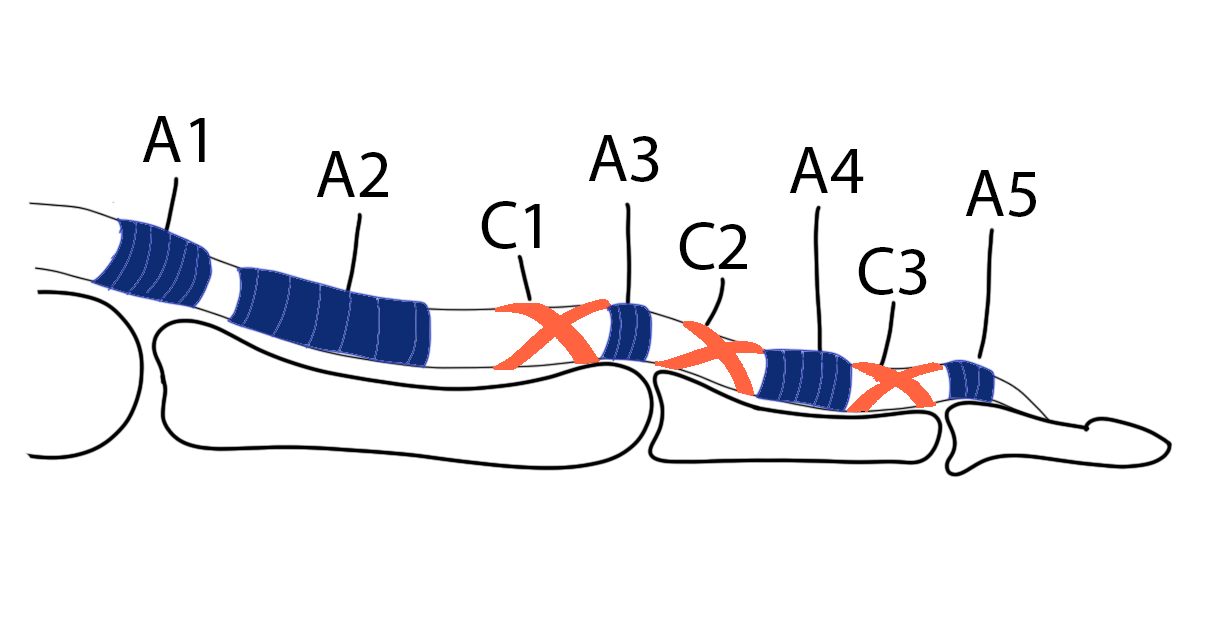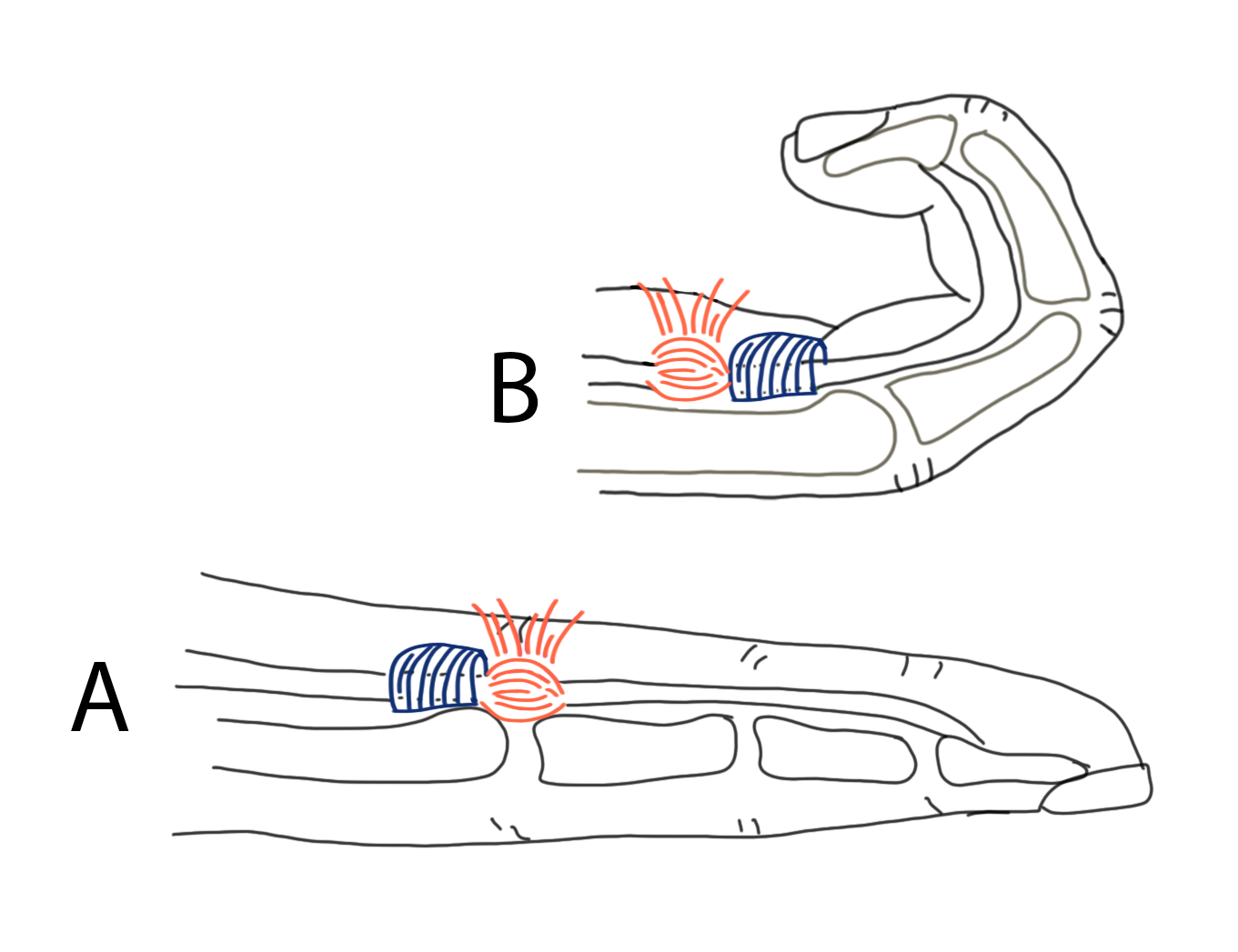Your Guide: Trigger Fingers and Trigger Thumbs
read time: 4 minutes
If you’d prefer a more in-depth podcast version of this information, I was invited on the “Nailed It” Orthopedic Surgery podcast to discuss all-things trigger finger. You can find it at the link included here or in the embedded video below. Enjoy!
A trigger finger or a trigger thumb, in its most basic form, is a flexor tendon of the hand that is getting stuck.
Specifically, a lump of swelling in the tendon gets lodged on a band of tissue in the palm known as the A1 pulley. This causes the finger to click, trigger, or even get locked in severe forms.
The pulley system in every finger
There are two flexor tendons in each finger and one in the thumb. When activated by muscles in the forearm, these tendons bend (flex) the fingers down to grip an object.
To do this in a repeatable and powerful way, the tendons run through a series of bands (essentially a continuous tunnel) known as the pulley system. This tunnel stretches from the palm to the fingertip — and the first band in the palm is known as the A1 pulley.
Trigger finger = A physical obstruction at the A1 pulley
Trigger finger may be the most common thing I see in my hand and upper extremity practice. It is estimated that 2-3% of the general population has a trigger finger at any given time. That’s over 90,000 new trigger fingers in the United States every year.
As common as trigger fingers are, we actually have a fairly limited understanding of why it occurs in any one person. In general, each trigger finger is likely the result of a small tendon injury that went unnoticed or the accumulation of repetitive small injuries over time.
We do know that patients with diabetes, hypothyroid, or some inflammatory conditions are more likely to develop trigger fingers — but just because you have a trigger finger does not mean that is a sign of developing the above conditions. Remember, trigger fingers are really common.
As a nodule of swelling develops on the flexor tendon, now each time you bend your finger (drawing A below) that nodule (in orange) will pop out from under the A1 pulley (in blue). As you try to straighten your finger back out (in drawing B), the lump will lodge on the front edge of the pulley because it can’t fit back under. This will either cause your finger to click, trigger, or fully lock.
As you can imagine this is both disconcerting and painful (though not always).
While the symptoms of a trigger finger are certainly annoying, it can be helpful to understand that this is not a dangerous condition. This nodule is not a cancer and trigger finger doesn’t spread to other areas of the body. It is not causing damage to your hand.
That being said, if you have a particularly painful trigger finger, what will happen is your brain will start to decrease how much it wants to move that finger. You may notice this but it can also be subconscious.
When that happens, the finger can start to get stiff. When your finger joints don’t move through their full range of motion, the surrounding soft tissues will tighten up and you may become unable to fully bend or extend your finger.
Now that’s a problem. This can take months to stretch out with therapy and in some cases can be permanent.
So as with anything, be smart about your symptoms.
Don’t let your finger start to stiffen up and ignore that for months or years.
It’s safe to wait on a trigger finger if you can fully move your finger, but if it begins causing other issues like this, see a hand surgeon before it’s too late.
How to get rid of your trigger finger
Trigger finger treatment is pretty straightforward. The goal is to get that lump to disappear so the tendon system can glide smoothly again.
Current strategies in order of increasing success are:
Do nothing (they often just go away)
Wear a finger splint at night for a maximum of 6 weeks (cures a trigger finger occasionally)
Have a steroid injection to shrink the nodule (very effective — here’s my article)
Have a minor surgery to divide the A1 pulley and clean off the nodule (nearly a universal cure).
While I wish I could report differently, there are no exercises, medications, or massage techniques that reliably treat a trigger finger.
Takeaways:
A trigger finger results from a physical lump of inflammatory tissue on a flexor tendon of your finger or thumb
This bump lodges on a band in the palm called the A1 pulley, resulting in a sensation of clicking, triggering, or even locking when you bend the affected finger
We have both nonsurgical and surgical treatment options that reliably cure trigger fingers
We will have plenty more to discuss about trigger fingers in the future. We’ll talk about injections, splinting, surgery, you name it.
But this primer should get you up to speed so you can actively participate in your care or easily digest future discussions on the topic.
As always, more to come.



